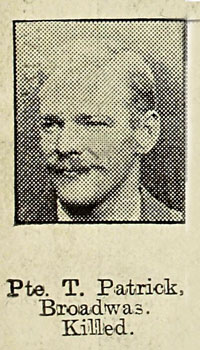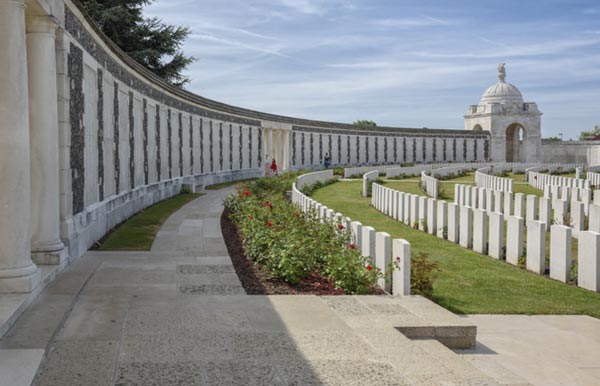Thomas Patrick
Return
Private
Battle of Poelcappelle, 11 October 1917.
© IWM Q 3006
Thomas Patrick
Service Number: 263175
Regiment & Unit/Ship
Worcestershire Regiment
4th Battalion
Date of Death
Died 09 October 1917
Age 31 years old
Buried or commemorated at
Tyne Cot Memorial
Panel 75 to 77.
Belgium
Country of Service
United Kingdom
Additional Info
Son of Mr. and Mrs. James Patrick, of
Broad Green, Broadwas-on-Teme, Worcester.
Family history
In October 1884, James Patrick and Fanny Ellen Rogers married. [registered Martley]
Their son Thomas Patrick was born in 1887.
In the 1911 Census the family was living in Broadwas.
Patrick Thomas
Rank: Private
Regiment: 4th Battalion Worcestershire Regiment
Service number: 263175
Conflict: WW1
Date of death: 9th October 1917 aged 31
Buried: Commemorated on Tyne Cot Memorial, Belgium, Panel 75 to 77.
Relatives: Son of Mr. and Mrs. James Patrick, of Broad Green, Broadwas-on-Teme, Worcestershire
Memorial: Broadwas St Mary Magdalene Church
Also appears on: Broadwas St Mary Magdalene Church WW1 Roll of Honour.
Credits: Parish magazine researched by Eve Fraser.
Details: United Parish Magazine, Broadwas, October 1918:
After many months of anxious waiting and hoping for news, we much regret to learn
that Mr and Mrs Patrick have heard from the War Office that there is no trace of their
son who has been missing. In their sorrow they know they have our deepest sympathy.
A photograph of Private Thomas Patrick of Broadwas in the Berrow's Worcester Journal
Supplement, Saturday 21st September 1918, available at Worcestershire Archives.
The 3rd battle of Ypres was launched by the allies on the 31st July 1917 and raged until the 10th November 1917,
the weather was notoriously wet, turning the difficult Flanders clay into an impossible quagmire.
Due to conditions of the battlefield, it was difficult to recover the remains of those who had lost their lives
and many remained where they fell, their names recorded on the panels of the Tyne Cot Memorial to the Missing.
The battle was made up of a number of actions, and one of them was the battle of Poelcappelle, which took
place on the 9th October 1917 was fought in Flanders, Belgium, by the British Second Army and
Fifth Army against the German 4th Army. [This is most likely where Thomas Patrick fell]
HISTORY INFORMATION
The Tyne Cot Memorial is one of four memorials to the missing in Belgian Flanders which cover the area known
as the Ypres Salient. Broadly speaking, the Salient stretched from Langemarck in the north to the northern
edge in Ploegsteert Wood in the south, but it varied in area and shape throughout the war.
The Salient was formed during the First Battle of Ypres in October and November 1914, when a small British
Expeditionary Force succeeded in securing the town before the onset of winter, pushing the German forces
back to the Passchendaele Ridge. The Second Battle of Ypres began in April 1915 when the Germans released
poison gas into the Allied lines north of Ypres. This was the first time gas had been used by either side and
the violence of the attack forced an Allied withdrawal and a shortening of the line of defence.
There was little more significant activity on this front until 1917, when in the Third Battle of Ypres an offensive
was mounted by Commonwealth forces to divert German attention from a weakened French front further south.
The initial attempt in June to dislodge the Germans from the Messines Ridge was a complete success,
but the main assault north-eastward, which began at the end of July, quickly became a dogged struggle
against determined opposition and the rapidly deteriorating weather. The campaign finally came to a close
in November with the capture of Passchendaele.
The German offensive of March 1918 met with some initial success, but was eventually checked and repulsed
in a combined effort by the Allies in September.
The battles of the Ypres Salient claimed many lives on both sides and it quickly became clear that the
commemoration of members of the Commonwealth forces with no known grave would have to be divided
between several different sites.
The site of the Menin Gate was chosen because of the hundreds of thousands of men who passed through
it on their way to the battlefields. It commemorates those of all Commonwealth nations, except New Zealand,
who died in the Salient, in the case of United Kingdom casualties before 16 August 1917 (with some exceptions).
Those United Kingdom and New Zealand servicemen who died after that date are named on the memorial at
Tyne Cot, a site which marks the furthest point reached by Commonwealth forces in Belgium until nearly the
end of the war. Other New Zealand casualties are commemorated on memorials at Buttes New British
Cemetery and Messines Ridge British Cemetery.
The TYNE COT MEMORIAL now bears the names of almost 35,000 officers and men whose graves are not known.
The memorial, designed by Sir Herbert Baker with sculpture by Joseph Armitage and F.V. Blundstone,
was unveiled by Sir Gilbert Dyett on 20 June 1927.
The memorial forms the north-eastern boundary of TYNE COT CEMETERY, which was established around a
captured German blockhouse or pill-box used as an advanced dressing station. The original battlefield
cemetery of 343 graves was greatly enlarged after the Armistice when remains were brought in from the
battlefields of Passchendaele and Langemarck, and from a few small burial grounds. It is now the largest
Commonwealth war cemetery in the world in terms of burials. At the suggestion of King George V, who
visited the cemetery in 1922, the Cross of Sacrifice was placed on the original large pill-box.
There are three other pill-boxes in the cemetery.
There are now 11,961 Commonwealth servicemen of the First World War buried or commemorated in
Tyne Cot Cemetery, 8,373 of these are unidentified.
The cemetery was designed by Sir Herbert Baker.
©peh





